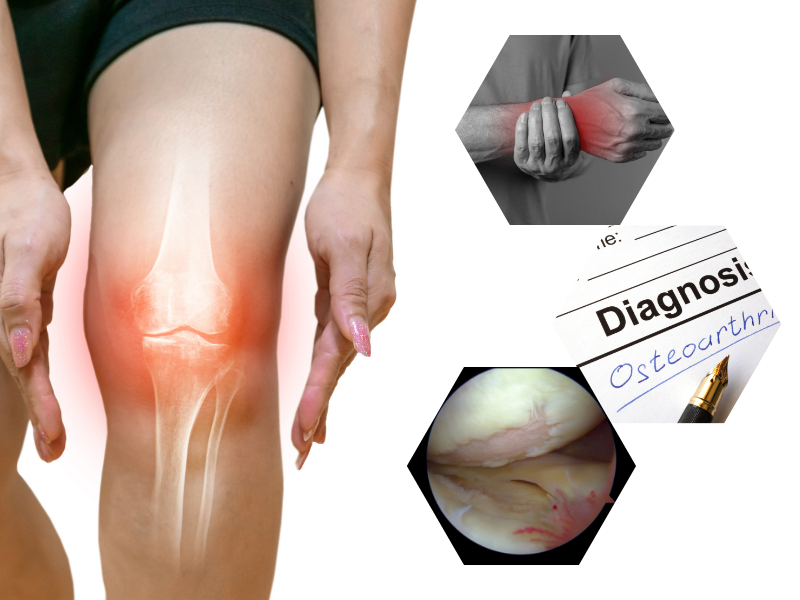Osteoarthritis

Osteoarthritis is a degenerative joint disease. It is by far the most common form of arthritis impacting millions globally. In this condition, the tissues in the joint break down over time.
Osteoarthritis (OA), often referred to as degenerative joint disease, is a chronic condition that primarily affects the joints. Unlike some other forms of arthritis, osteoarthritis does not involve inflammation of the synovium, the lining of the joints. Instead, it primarily targets the cartilage, the protective tissue covering the ends of bones within a joint.
What happens in osteoarthritis?
In OA, the breakdown of joint tissues begins without a known trigger. The condition damages various parts of the joint, including:
· Tendons
· Cartilage
· Ligaments
· Bone
· Synovium
· Meniscus
This soft tissue damage leads to symptoms like:
· Pain when moving the joint.
· Joint swelling after a lot of activity.
· Joint stiffness that lasts less than 30 minutes after resting.
· The sensation that the joint is loose or unstable.
· Reduced joint motion
· Bone spurs
· Loss of flexibility
· Tenderness
· Grating sensation
Symptoms frequently begin slowly and worsen with time.
Joint pain can result in decreased activity. This can lead to muscle weakness and increased stress on the joint. Over time, the joint may undergo shape changes. Bone spurs may develop. Bone or cartilage fragments can break off, causing additional harm.
What causes Osteoarthritis?
Osteoarthritis occurs when the cartilage and other tissues within the joint degrade or alter in structure. This is not due to normal wear and strain on the joints. Changes in the tissue, on the other hand, might cause disintegration, which normally occurs gradually over time.
Certain factors may make it more likely for you to develop the disease, including:
· Being overweight or obese
· Aging
· History of injury or surgery to a joint.
· Joints that do not form correctly.
· Overuse from repetitive movements of the joint.
· Family history of osteoarthritis.
What are the risk factors for osteoarthritis?
Factors that may elevate your susceptibility to osteoarthritis encompass:
1. Advanced Age: The likelihood of osteoarthritis rises with increasing age.
2. Excess Body Weight: Obesity plays a significant role in osteoarthritis development. Carrying extra weight places additional stress on weight-bearing joints. This intensifies the risk. Furthermore, adipose tissue generates proteins that can cause severe inflammation in and around the joints.
3. Gender: Women exhibit a higher tendency to develop osteoarthritis, although the precise reasons remain unclear.
4. Joint Injuries: Injuries can heighten the likelihood of osteoarthritis. Even injuries seemingly healed many years ago can elevate the risk.
5. Genetic Predisposition: Some individuals inherit a genetic predisposition to develop osteoarthritis.
6. Repetitive Joint Stress: Occupations or sports involving repetitive stress on a joint can lead to the eventual development of osteoarthritis in that joint.
7. Bone Deformities: Certain individuals are born with malformed joints or defective cartilage. This increases their vulnerability to this condition.
8. Metabolic Diseases: Specific metabolic conditions are associated with an elevated risk of this condition. This includes:
· diabetes
· excess iron in the body
What are the medication options for OA?
Medications for managing pain and inflammation associated with OA come in various forms, including pills, syrups, patches, gels, creams, or injectables. These encompass:
1. Analgesics: These pain relievers consist of acetaminophen and opioids. Acetaminophen is readily available over the counter (OTC), while opioids require a prescription from a doctor.
2. Nonsteroidal Anti-Inflammatory Drugs (NSAIDs): Widely used for alleviating inflammation and pain, NSAIDs include:
· Aspirin
· Ibuprofen
· Naproxen
· Celecoxib
They are accessible either OTC or by prescription. OTC versions assist with pain relief but do not address inflammation.
3. Counterirritants: OTC products containing ingredients like capsaicin, menthol, and lidocaine work by irritating nerve endings. This irritation creates sensations of cold, warmth, or itchiness in the affected area. Thus, diverting attention from the actual pain.
4. Corticosteroids: Prescription anti-inflammatory medications operating similarly to the hormone cortisol. These medications can be taken orally or injected directly into the joint under medical supervision.
5. Other Drugs: Oral medications like the antidepressant duloxetine and the anti-seizure drug pregabalin are FDA-approved for treating osteoarthritis pain.



